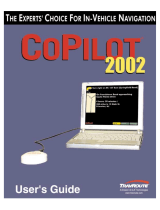
190-00870-00 Rev. B
Garmin G950 Pilot’s Guide for the Pilatus PC-6
vii
TABLE OF CONTENTS
Clearance Recorder and Player ................................... 121
Split COM Operation ................................................. 122
Entertainment Inputs ................................................ 123
Multifunction Controls .............................................. 124
4.6 Audio Panel Preflight Procedure ....................... 125
4.7 Abnormal Operation ........................................... 126
Stuck Microphone ..................................................... 126
COM Tuning Failure ................................................... 126
Audio Panel Fail-safe Operation ................................. 126
PFD Failure (Reversionary Mode) ............................... 126
SECTION 5 FLIGHT MANAGEMENT
5.1 Introduction ......................................................... 127
Navigation Status Box ............................................... 129
5.2 Using Map Displays ............................................. 130
Map Orientation ....................................................... 130
Map Range .............................................................. 132
Map Panning ............................................................ 134
Measuring Bearing and Distance ................................ 139
Topography .............................................................. 140
Map Symbols ........................................................... 143
Airways ................................................................... 149
Track Vector ............................................................. 151
Wind Vector ............................................................. 152
Nav Range Ring........................................................ 153
Fuel Range Ring ....................................................... 154
5.3 Waypoints ............................................................. 155
Airports ................................................................... 156
Intersections ............................................................ 162
NDBs ....................................................................... 164
VORs ....................................................................... 166
User Waypoints ........................................................ 168
5.4 Airspaces .............................................................. 174
5.5 Direct-to-Navigation .......................................... 178
5.6 Flight Planning ..................................................... 185
Flight Plan Creation .................................................. 186
Adding Waypoints to an Existing Flight Plan ................ 191
Adding Airways to a Flight Plan ................................. 193
Adding Procedures to a Stored Flight Plan .................. 196
Flight Plan Storage ................................................... 203
Flight Plan Editing .................................................... 205
Along Track Offsets ................................................... 208
Parallel Track ............................................................ 210
Activating a Flight Plan Leg ....................................... 213
Inverting a Flight Plan ............................................... 214
Flight Plan Views ...................................................... 215
Closest Point of FPL .................................................. 217
5.7 Vertical Navigation ............................................. 218
Altitude Constraints .................................................. 220
5.8 Procedures ........................................................... 224
Departures ............................................................... 224
Arrivals ................................................................... 227
Approaches ............................................................. 229
5.9 Trip Planning ........................................................ 235
Trip Planning ............................................................ 235
5.10 RAIM Prediction................................................... 239
5.11 Navigating a Flight Plan ..................................... 243
5.12 Abnormal Operation ........................................... 271
SECTION 6 HAZARD AVOIDANCE
6.1 Airborne Color Weather Radar .......................... 273
System Description ................................................... 273
Principles of Pulsed Airborne Weather Radar ............... 274
Safe Operating Distance ............................................ 278
Basic Antenna Tilt Setup ............................................ 278
Weather Mapping and Interpretation ......................... 280
Ground Mapping and Interpretation ........................... 292
6.2 WX-500 Stormscope ........................................... 293
Setting Up Stormscope on the Navigation Map ........... 293
Selecting the Stormscope Page .................................. 298
6.3 Terrain Proximity ................................................. 299
Displaying Terrain Proximity Data ............................... 300
Terrain Proximity Page ............................................... 302
6.4 TAWS-B .................................................................304
Displaying TAWS-B Data ............................................ 305
TAWS-B Page ........................................................... 308
TAWS-B Alerts .......................................................... 310
System Status ........................................................... 316
6.5 Traffic Information Service (TIS) ........................ 318
Displaying TRAFFIC Data ........................................... 319
Traffic Map Page ....................................................... 322
TIS Alerts ................................................................. 323
System Status ........................................................... 324























